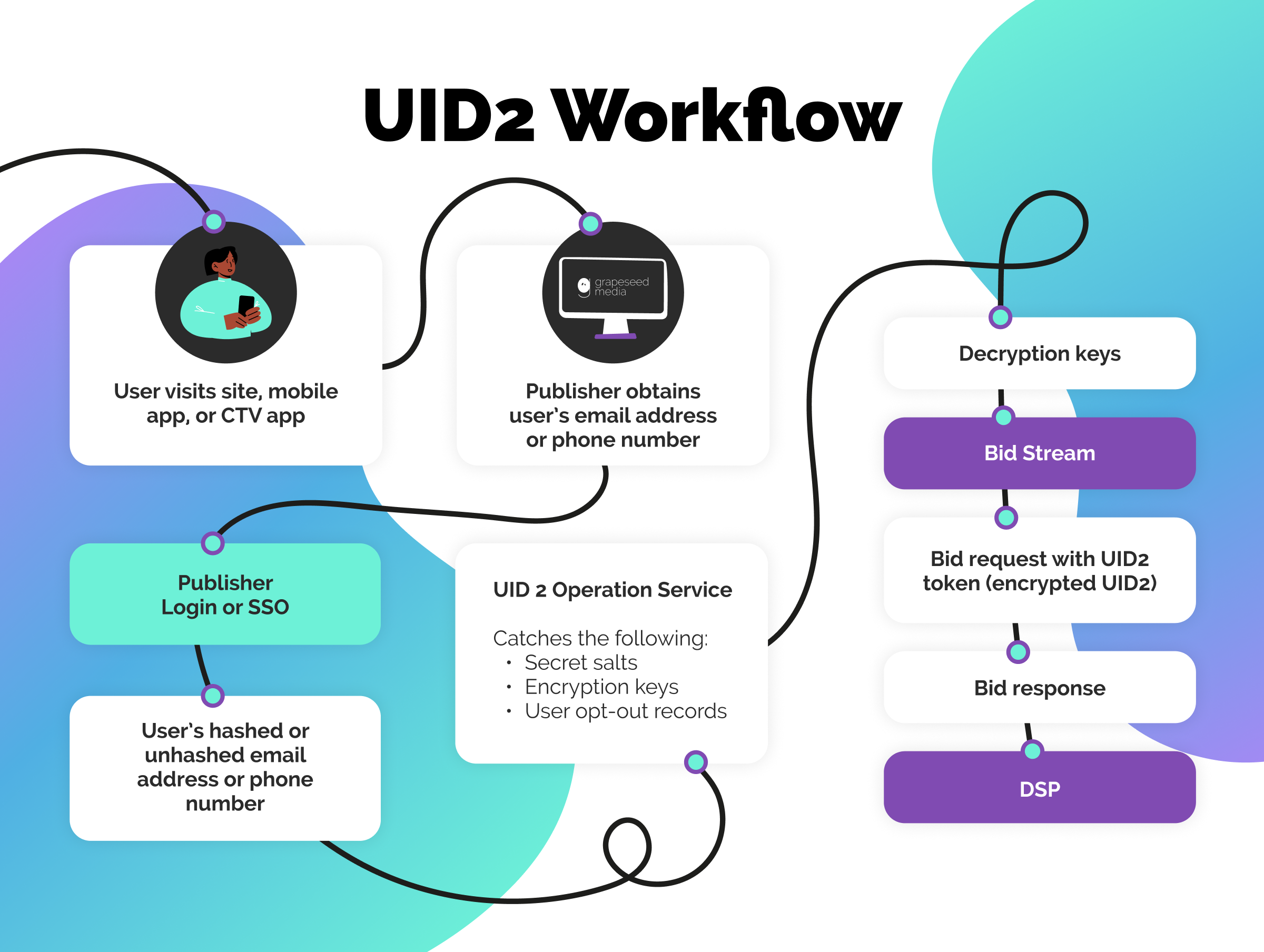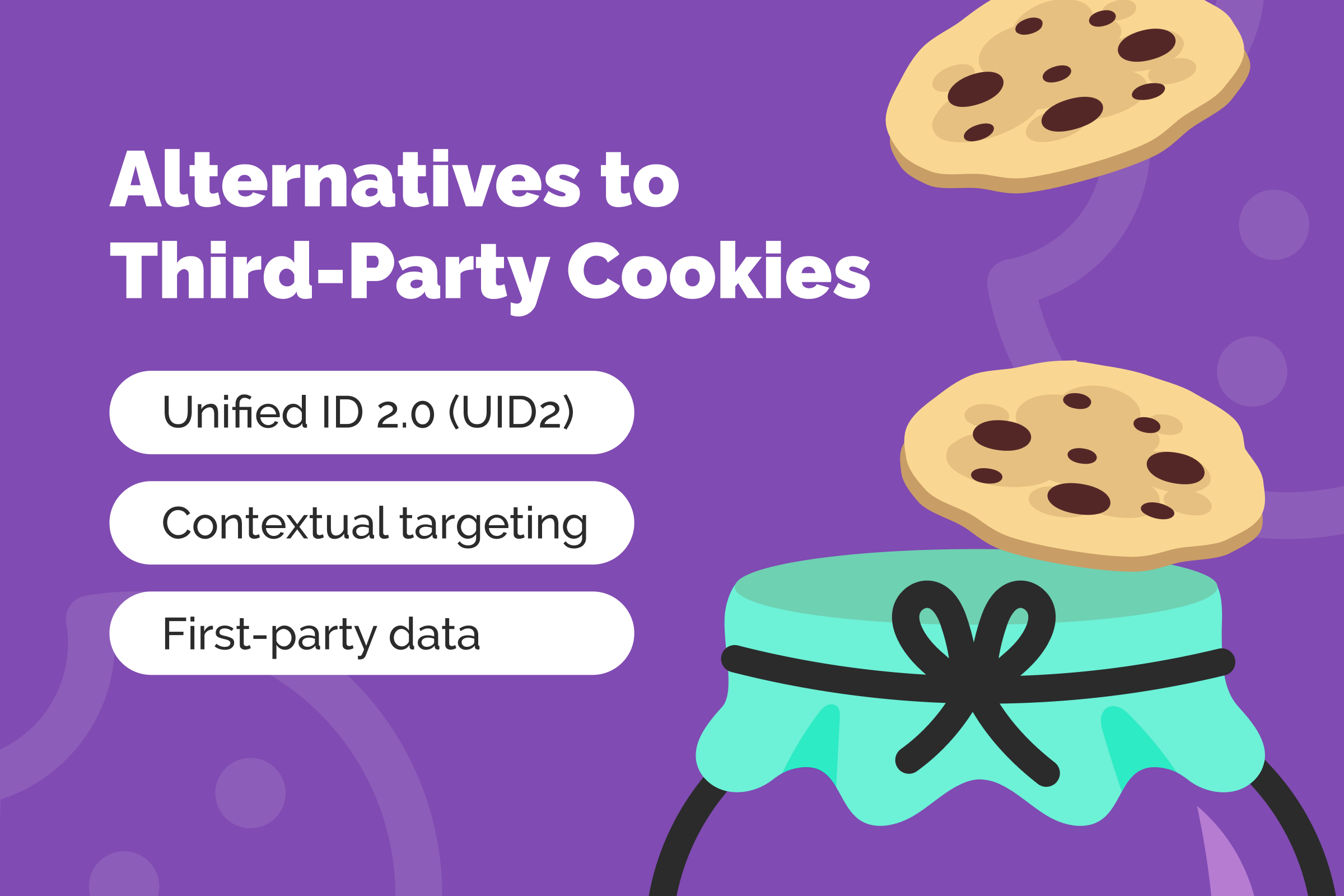Third-party cookies — those little pieces of data that followed users around the internet tracking their behavior so that advertisers could target them — are a thing of the past.
In this new, cookieless world, user privacy is everything, and the amount of user information that sites can track and share is restricted.
While this has been a wake-up call for advertisers, who have relied heavily on cookies for tracking user behavior across websites and published content, the good news is that there are ways to accurately target users without infringing on their privacy.
Perhaps you’re already running cookieless campaigns and want to know how to make them more effective, or maybe you’re just about to take your first steps into the world of cookieless advertising.
Either way, we’ve got you covered — in this blog post, the Grapeseed Media programmatic experts reveal the inner workings of the new cookieless identity solutions.
Take a look.
Understanding Unified ID 2.0 (UID2)
Unified ID 2.0 (UID2) was created by The Trade Desk when they began to foresee the cookieless future looming on the horizon and decided to design alternatives. Since then, they’ve been working to get all DSPs and publishers across the internet on board.
Whereas cookies would “stick” to users and follow them around the internet, UID2 takes a different approach to identification, using directly identifiable information (DII) instead of personal identification information (PII) in the form of phone numbers and email addresses.
Websites can use this information to identify the users that browse them, but not to track their behavior on other websites. So, rather than cookies following users around the internet, it’s the user who leaves a trail of breadcrumbs for advertisers to follow.
The idea is that every publisher eventually opts in to UID2, so that even websites that don’t have a login option can access this data. Joining UID2 will be in the best interest of most websites as it will open up more revenue possibilities for them, and once they do, it will be business as usual.
Besides enabling advertisers to target users while respecting their privacy, UID2 also works for CTV, unlike cookies, which were not able to target CTV users.
Here’s how it works:
- A user logs in to their account using their email address or phone number.
- The publisher obtains this information.
- They then hash the information so it can’t be obtained by other parties.
- The publisher sends the protected information to a UID2 service provider, such as The Trade Desk.
- The encrypted information is then sent to a DSP as a targetable audience.
- Advertisers and publishers can bid back and forth on the bid stream and target users with relevant ads.

But how does all of this translate into a cookieless solution?
Well, the easiest way is through a DSP that offers UID2 data, such as The Trade Desk. However, if that’s not available to you, you can take a tactical approach using contextual methods, focusing on page content rather than user ID.
That might sound like taking it back to the early days of digital advertising, and you’d be right — but the tech’s come a long way since then, so let’s have a look at how you can leverage it.
Contextual Targeting: an Alternative to Third-Party Cookies
Contextual targeting is a way for advertisers to get around the need for third-party cookies. Since contextual targeting focuses on content or keywords and content instead of users, it’s an effective, privacy-compliant, cookie-free solution.
It’s as simple as it sounds: targeting users based on the content of the pages they view, and placing your ads on highly-viewed pages.
However, while contextual targeting might give you a report of which pages are viewed most and what users do after reaching a page, it doesn’t offer the precise attribution features of cookies.
For instance, it’s difficult to infer causation from contextual advertising — did a click on a blog lead to a purchase, or did other factors contribute to the conversion?
Contextual targeting also removes the user from the equation and focuses on content, which makes it difficult to know whether the user has even seen the ad. However, you can combine contextual targeting with other, more robust tracking methods, such as:
- Contextual benchmarking with cookies: Use all identifiers available to you, even if they’re more limited than before and might soon reduce to zero. This helps you set benchmarks while cookies are still available to compare your cookie audiences with the cookie-free audiences of the future.
- Probabilistic IDs: These tools are common in Europe but are increasingly becoming table stakes in North America and Asia-Pacific as well. These IDs help close the gap between authenticated and ID-less traffic.
First-Party Data
First-party data is information that a company collects directly from its customers or audience. This data can include details like people’s names, what they buy, how often they visit a website, or what they say in surveys.
First-party data can help you run high-performing campaigns without relying on third-party cookies. Here’s how:
- Knowing your audience: Collecting your own data can provide insights into what your customers like, how they behave, and what they are interested in so you can create ads that are relevant to them.
- Personalization: With first-party data, you can tailor ads to individual preferences. For example, if you know a user loves video games from their browsing history on your site, you can show them ads for new game releases.
- Customer loyalty programs: Loyalty programs encourage customers to share more information in exchange for rewards. This provides you with more data while building a stronger relationship with customers.
- Diverse communication channels: Collecting first-party data allows you to personalize your communications with your audience across diverse channels, such as email, social media, or mobile apps.
- Lookalike audiences: Understanding your current customers can help you build lookalike audiences and find new customers who share similar interests and behaviors, expanding your reach without needing third-party cookies.
- Privacy and transparency: Since first-party data comes directly from customers, you need to be transparent about how you use this data and respect privacy choices. This builds trust and can improve campaign performance because customers feel safe sharing their information.
Thrive in the Post-Cookie World with Grapeseed Media

The disappearance of third-party cookies marks the start of a new era for digital advertising, and the shift offers an opportunity to innovate and refine advertising strategies, ensuring they respect user consent and privacy.
This transition may seem daunting, but with the right approach and support, you can turn these changes into an advantage for your brand.
If you’re looking for an agency partner to help you craft a cookieless campaign that delivers, book a strategy call with Grapeseed Media.
Our team of programmatic advertising experts will be happy to discuss the best options with you.






